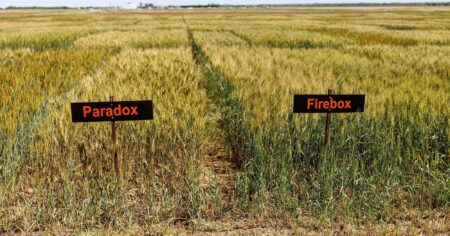What Happened
Many agricultural commodities have tradeable futures and options contracts. Few industries offer an avenue to manage risk and opportunities the way the various exchanges for agriculture do. Today, we’ll use corn as an example. Corn is traded at the Chicago Board of Trade. Traders have the ability to buy and sell futures or buy and sell options. Our focus will narrow down to selling call option premium to create a revenue stream while, at the same time, challenging the underlying futures contract to rally.
Why This Is Important
For many years, the corn market has offered little positive margin. Futures tend to trade in the vicinity of a breakeven price for long stretches of time. Occasionally, strong demand, adversity in production, or both, helps boost prices. In most years (such as 2024 and again this year, so far), corn futures prices have reflected enough inventory on hand or enough projected production to limit price appreciation. There are some who might say you should sell far in advance to take advantage of higher deferred contract prices (if they exist). This can be done using futures or forward selling. However, both have some potential problems that may not be suitable for your operation. Forward contracting is generally not offered for longer terms (more than 18 months out). If it is, the basis (the difference of the cash and futures prices) is usually considerably wide and, therefore, not attractive. Selling futures in a brokerage account is possible, yet could entail significant margin requirements. Hedge-to-arrive contracts are an alternative. Once in place, like forward contracts, hedge-to-arrive contracts require delivery. Each alternative has pros and cons, and must be measured before establishing a position.
A different approach from locking in a price is to collect premiums and challenge the market to rally. This is accomplished by selling out-of-the-money call options. The goal is to collect revenue from the short calls and add this to your bottom line, or to receive a short futures position (hedge), if prices rally and finish above the sold strike price. Whether the short call expires without value at its expiration date or is exercised, you still collect the premium.
As an example, if you sold a December 2026 $6 call option for 12¢, you collect 12¢ at the expiration date if December 2026 futures are below $6. If December 2026 futures are above $6, you will be assigned a short futures position at $6. You still collect the 12¢, so your breakeven is $6.12, plus commissions and fees. This doesn’t happen without risk. The exchange will require an initial margin on your futures positions, which is a good faith deposit. Maintenance margin is additional money needed if the position works against you.
What Can You Do?
Remember, the goal is to create revenue to help the bottom line. Talk to your adviser about the advantages, disadvantages, and risks associated with selling call options.
Start slowly, learn how this works, and how you feel about it. Marketing is always a challenge, yet the more knowledge and alternatives you have, the more confident in decision-making you’ll be. Selling call options is another tool in your marketing toolbox. Knowing when and how to sell options could prove beneficial to your overall approach to marketing.
Find What Works for You
Work with a professional to find the strategy or strategies best suited for your operation. Communication is important. Ask critical questions and garner a full comprehension of consequences and potential rewards before executing. The idea is to make good decisions for the operation rather than emotionally charged responses to market moves, which are always dynamic.
Editor’s Note: If you have any questions on this Perspective, feel free to contact Bryan Doherty at Total Farm Marketing: (800) 334-9779.
Disclaimer: The data contained herein is believed to be drawn from reliable sources but cannot be guaranteed. Individuals acting on this information are responsible for their own actions. Commodity trading may not be suitable for all recipients of this report. Futures and options trading involve significant risk of loss and may not be suitable for everyone. Therefore, carefully consider whether such trading is suitable for you in light of your financial condition. Examples of seasonal price moves or extreme market conditions are not meant to imply that such moves or conditions are common occurrences or likely to occur. Futures prices have already factored in the seasonal aspects of supply and demand. No representation is being made that scenario planning, strategy, or discipline will guarantee success or profits. Any decisions you may make to buy, sell, or hold a futures or options position on such research are entirely your own and not in any way deemed to be endorsed by or attributed to Total Farm Marketing. Total Farm Marketing and TFM refer to Stewart-Peterson Group Inc., Stewart-Peterson Inc., and SP Risk Services LLC. Stewart-Peterson Group Inc. is registered with the Commodity Futures Trading Commission (CFTC) as an introducing broker and is a member of the National Futures Association. SP Risk Services, LLC is an insurance agency and an equal opportunity provider. Stewart-Peterson Inc. is a publishing company. A customer may have relationships with all three companies. SP Risk Services LLC and Stewart-Peterson Inc. are wholly owned by Stewart-Peterson Group Inc. unless otherwise noted, services referenced are services of Stewart-Peterson Group Inc. Presented for solicitation.
About the Author: With the wisdom of 30 years at Total Farm Marketing and a following across the Grain Belt, Bryan Doherty is deeply passionate about his clients, their success, and long-term, fruitful relationships. As a senior market advisor and vice president of brokerage solutions, Doherty lives and breathes farm marketing. He has an in-depth understanding of the tools and markets, listens, and communicates with intent and clarity to ensure clients are comfortable with the decisions.


:max_bytes(150000):strip_icc()/DC-5ec71dd349104ec287b318f05ebf5f74.jpg)
:max_bytes(150000):strip_icc()/SFCE_Sp25_WortheyFarmersMarket_preview1-9c3c0b2c5e9444249fa60594b7f30fec.jpg)
:max_bytes(150000):strip_icc()/TaylorsFireworkssign-c3dd3eb41cc646c593dbebfee850bdc0.jpg)


:max_bytes(150000):strip_icc()/iStock-601942830-2000-eb18c8a4364644918d9f14375bd9b463.jpg)

:max_bytes(150000):strip_icc()/diseaseplaybookcorntarspot-fb7ff9d7c32e4e63b3e5e97dbe406eeb.jpg)
